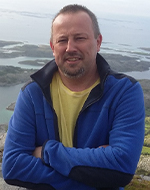基于电调制光谱、时间分辨微波光电导率和深能级瞬态光谱的范德瓦尔斯晶体研究
日期:2025/01/13 - 2025/01/13
学术讲座:基于电调制光谱、时间分辨微波光电导率和深能级瞬态光谱的范德瓦尔斯晶体研究
主讲人:Robert Kudrawiec, Professor, Department of Semiconductor Materials Engineering, Wroclaw University of Science and Technology
时间:2025年1月13日(周五)上午10:00
地点: 密西根学院龙宾楼403
讲座摘要
In this presentation I will present our recent progress in the application of electromodulation spectroscopy (EM), time resolved microwave photoconductivity (TRMC) and deep-level transient spectroscopy (DLTS) to study van der Waals (vdW) crystals, including transition metal dichalcogenides (TMDs), and hybrid heterostructures composed of vdW crystals and III-Nitrides.
Due to the Franz-Keldysh effect the EM spectroscopy can be applied to investigate the built-in electric field in semiconductor heterostructures as well as the Fermi level position on semiconductor surface and interfaces including vdW/GaN interfaces [1, 2]. In this presentation I will show how to determine the distribution of electric field in vdW/GaN heterostructures and the Fermi level position at the van der Waals/III-N interface. For graphene/GaN heterostructures CER studies reveal that after deposition of a graphene the Fermi level is unpinned from native GaN surface states and, instead, located at a graphene/GaN interface characteristic energy [1]. Deposition of h-BN on GaN induces an enlargement of the surface barrier height at the GaN surface. Such an effect translates to Fermi level pinning deeper inside the GaN band gap. As an explanation, a mechanism based on electron transfer from GaN surface states to the native acceptor states in h-BN is proposed [2].
The high exciton binding energies in TMDs do not help in the production of photocurrent, but there are many literature reports which show that photocurrent can be effectively generated in TMDs. It is generally assumed that point defects, which can lead to exciton dissociation, play a key role in this process. In this presentation, I will present our recent research in this area, starting with the detection of long-lived carriers and exciton dissociation time for bulk and single layers of TMDs using TRMC [3], followed by the study of native point defects with the DLTS supported by first-principles calculations [4]. We observed that the process of exciton capturing by traps after photoexcitation is fast but the occupation of traps by carriers is very long like for surface states and point defects. For this reason, an excess of long-lived carriers is observed for TMDs in TRMC. In this talk I will present and discuss the exciton dissociation mechanism, its dynamics, and the carrier dynamics in TMD for both n- and p-type bulk crystals and single monolayers of MoS2, MoSe2, WS2, and WSe2.
主讲人简介
Robert Kudrawiec received the M.S. and Ph.D. (Hons.) degrees in physics from the Wrocław University of Science and Technology (WUST), Poland, in 2000 and 2004, respectively, and the D.Sc. (Habilitation) degree in physics from the Institute of Physics, WUST, in 2010. His Ph.D. thesis was devoted to dilute nitrides. During the M.S. and Ph.D. studies, he focused on applications of the modulation spectroscopy to investigate the electronic band structure of low dimensional semiconductor heterostructures. From 2006 to 2007, he was a Post-Doctoral Scholar with Stanford University, Stanford, CA, where his research was centered on the band structure and defects in GaInNAsSb–GaAs materials. From 2012 to 2013, he was a Researcher with the Lawrence National Berkeley Laboratory, Berkeley, CA, where his activity was focused on novel III–V and II–VI materials dedicated for solar cell applications. Since 2018, he has been a full Professor with the Faculty of Fundamental Problems of Technology, WUST. He has co-authored over 400 publications in refereed journals in his research areas. His current research interests include the application of photoreflectance, contactless electroreflectance, micro-photoluminescence, time resolved photoluminescence spectroscopies, time resolved microwave photoconductivity and other optical techniques to investigate the optical properties of III-N materials and low dimensional structures, and recently perovskites and van der Waals crystals including graphene, h-BN, monochalcogenides, and dichalcogenides. Since 2017 he is associated with the Polish Center for Technology Development at Wroclaw, where he is working on UV light emitters and hybrid van der Waals/AlGaN photodetectors for UV spectral range. In 2019, he founded the Department of Semiconductor Materials Engineering at WUST, which focuses on optical studies of van der Waals crystals, perovskites and van der Waals/III-N and perovskite/III-N hybrid heterostructures.
